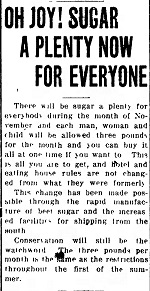While
the community was anxious to re-open, deaths caused by Influenza were
still occurring. Multiple members of family households were still
battling the wicked virus. And many were dying..
Iowa City had been closed down for four long weeks. But regardless of the Influenza continuing to haunt Johnson County, Iowa City was re-opened on November 2. Churches and businesses wasted no time opening their doors. University athletic authorities urged a large attendance at the upcoming game between Iowa and Illinois. On November 4, city schools and the university were open again. The Iowa City school district took every precaution to safeguard their pupils after re-opening. The following rules were established:
Johnson county residents enjoyed their renewed freedom to move about and so did the Influenza. In just three days, after the quarantine was cancelled, nearly thirty cases were known. It’s likely there were more cases because the case count was based only if a physician had been called. In those days, only doctors were authorized to report cases. Dr. Rohrbacher warned the community that just because the city’s quarantine was lifted, it didn’t mean citizens were out of danger. On November 7th, he made the following statement to the public: “Although
the quarantine has been lifted the danger is not past. It was hoped
that after five weeks of influenza in our midst and four weeks of
quarantine with the loss of many of our best citizens that when the
quarantine was lifted, the people of Iowa City would not gather
together any more than was absolutely necessary. The intermingling of
people has not been avoided as it should. If not taken more serious, we
shall be placed in restraint again, for we certainly do not care to
have our recent experience repeated.”
On the 11th hour of the 11th day of the 11th month, the Great War ended. The community was thrilled their young soldiers would be coming home. But not all of them would be returning....Johnson County had lost 38 of their lovings sons. Influenza and pneumonia was responsible for the death of 28 of them. By the end of the month, Johnson County had taken a serious turn with the Flu epidemic. Spanish Influenza was sweeping over Iowa City. The Mayor warned it was serious - 90 cases suddenly emerged over just a few days. There were six deaths in thirty hours. Interestingly enough, however, the University was not negatively impacted with a surge of new cases. Their established safeguards had continued to keep the disease in check.
(Click to
enlarge)
The Spanish Influenza had no regard for holidays. On Thanksgiving, the viscious disease robbed the Iowa CIty community of numerous valued citizens. Ralph W. Abbott, 38 years of age, died of pneumonia on Thanksgiving morning following a week’s illness. Charles D. Stanton, age 53, a husband and a father of three, also died of pneumonia on that day. Mrs. Belle Webb, was the sixth person within a 24 hour time period to become a fatal victim. Mrs. Webb, age 55, a resident of the Strand Apartments, died at a local hospital on Thanksgiving Day.
|
Page updated 17 April 2020



